- Clone
- JM7A4 (See other available formats)
- Regulatory Status
- RUO
- Other Names
- IL-15Rα chain, IL-15R, IL-15Rα
- Isotype
- Mouse IgG2b, κ
- Ave. Rating
- Submit a Review
- Product Citations
- publications
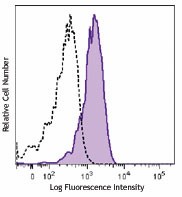
-

IFN-γ and LPS-stimulated (24 hours) human peripheral blood monocytes were stained with CD215 (clone JM7A4) APC (filled histogram) or mouse IgG2b, κ APC isotype control (open histogram).
| Cat # | Size | Price | Quantity Check Availability | Save | ||
|---|---|---|---|---|---|---|
| 330209 | 25 tests | $144 | ||||
| 330210 | 100 tests | $298 | ||||
IL-15 receptor α (IL-15Rα) is a cytokine receptor with the structural homology to IL-2Rα (CD25). Both α receptors contain a group of β sandwich protein called sushi domains. Similar to IL-2Rα, IL-15Rα is able to form a heterotrimer with their β chain (CD122) and common γ chain (γc, CD132). But unlike IL-2Rα subunit, IL-15Rα itself binds to IL-15 with equivalent high affinity compared with the heterotrimeric complex. IL-15Rα is expressed as soluble or transmembrane forms by variety cells, such as activated monocytes, dendritic cells, CD8+ memory T cells, NK or NKT cells. IL-15Rα by itself forms stable complexes with IL-15 on cell surface and presents IL-15 in trans to neighboring cells. IL-15, like IL-2, is a pleiotropic four-helix bundle cytokine and plays a key role in promoting T and B cell survival and proliferation, preferentially in memory CD8+ T cell proliferation, and NK/NKT cell development.
Product DetailsProduct Details
- Verified Reactivity
- Human
- Reported Reactivity
- African Green, Baboon, Cynomolgus, Rhesus
- Antibody Type
- Monoclonal
- Host Species
- Mouse
- Formulation
- Phosphate-buffered solution, pH 7.2, containing 0.09% sodium azide and BSA (origin USA)
- Preparation
- The antibody was purified by affinity chromatography and conjugated with APC under optimal conditions.
- Concentration
- Lot-specific (to obtain lot-specific concentration and expiration, please enter the lot number in our Certificate of Analysis online tool.)
- Storage & Handling
- The antibody solution should be stored undiluted between 2°C and 8°C, and protected from prolonged exposure to light. Do not freeze.
- Application
-
FC - Quality tested
- Recommended Usage
-
Each lot of this antibody is quality control tested by immunofluorescent staining with flow cytometric analysis. For flow cytometric staining, the suggested use of this reagent is 5 µl per million cells in 100 µl staining volume or 5 µl per 100 µl of whole blood.
- Excitation Laser
-
Red Laser (633 nm)
-
Application References
(PubMed link indicates BioLegend citation) - Product Citations
-
- RRID
-
AB_2561439 (BioLegend Cat. No. 330209)
AB_2561440 (BioLegend Cat. No. 330210)
Antigen Details
- Distribution
-
Dendritic cells, activated monocytes, memory CD8 T cells and NK/NKT cells
- Function
- Support T and B cell proliferation and development, preferentially for memory CD8+ T cell proliferation, and NK/NKT cell development
- Ligand/Receptor
- IL-15 with high affinity
- Cell Type
- Dendritic cells, Monocytes, NK cells, NKT cells, T cells
- Biology Area
- Immunology
- Molecular Family
- CD Molecules, Cytokine/Chemokine Receptors
- Antigen References
-
1. Giri JG, et al. 1995. EMBO J. 14:3654.
2. Giron-Michel J, et al. 2005. Blood 106:2302.
3. Lorenzen I, et al. 2005. J. Biol. Chem. 281:6642.
4. Sato N, et al. 2007. Proc. Natl. Acad. Sci. USA. 104:588. - Gene ID
- 3601 View all products for this Gene ID
- UniProt
- View information about CD215 on UniProt.org
Related Pages & Pathways
Pages
Related FAQs
Other Formats
View All CD215 Reagents Request Custom Conjugation| Description | Clone | Applications |
|---|---|---|
| Biotin anti-human CD215 (IL-15Rα) | JM7A4 | FC |
| PE anti-human CD215 (IL-15Rα) | JM7A4 | FC |
| APC anti-human CD215 (IL-15Rα) | JM7A4 | FC |
| TotalSeq™-D0947 anti-human CD215 (IL-15Rα) | JM7A4 | PG |
| TotalSeq™-C0947 anti-human CD215 (IL-15Rα) | JM7A4 | PG |
Customers Also Purchased
Compare Data Across All Formats
This data display is provided for general comparisons between formats.
Your actual data may vary due to variations in samples, target cells, instruments and their settings, staining conditions, and other factors.
If you need assistance with selecting the best format contact our expert technical support team.
-
Biotin anti-human CD215 (IL-15Rα)
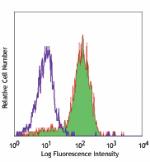
IFN-γ + LPS-stimulated human peripheral blood monocytes stai... -
PE anti-human CD215 (IL-15Rα)
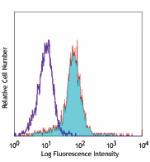
IFN-γ + LPS-stimulated human peripheral blood monocyte... -
APC anti-human CD215 (IL-15Rα)
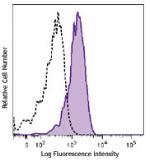
IFN-γ and LPS-stimulated (24 hours) human peripheral blood m... -
TotalSeq™-D0947 anti-human CD215 (IL-15Rα)
-
TotalSeq™-C0947 anti-human CD215 (IL-15Rα)
 Login/Register
Login/Register 










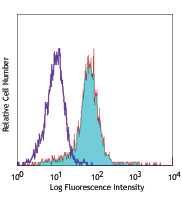
_100913.jpg)
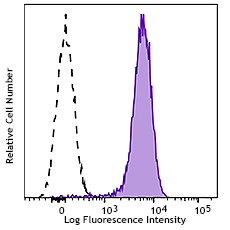




Follow Us